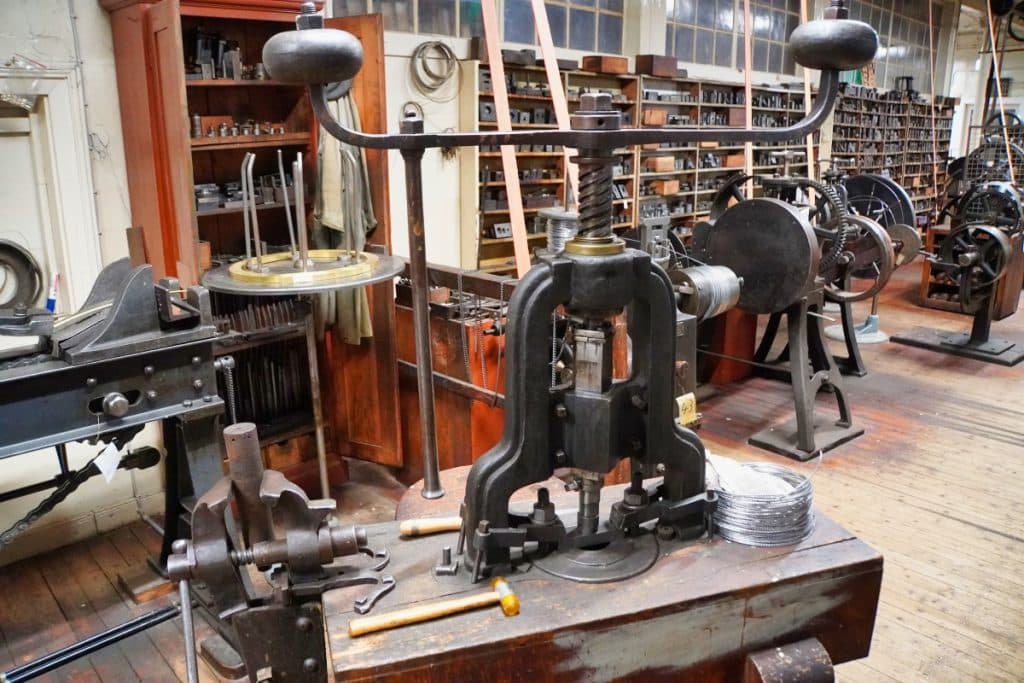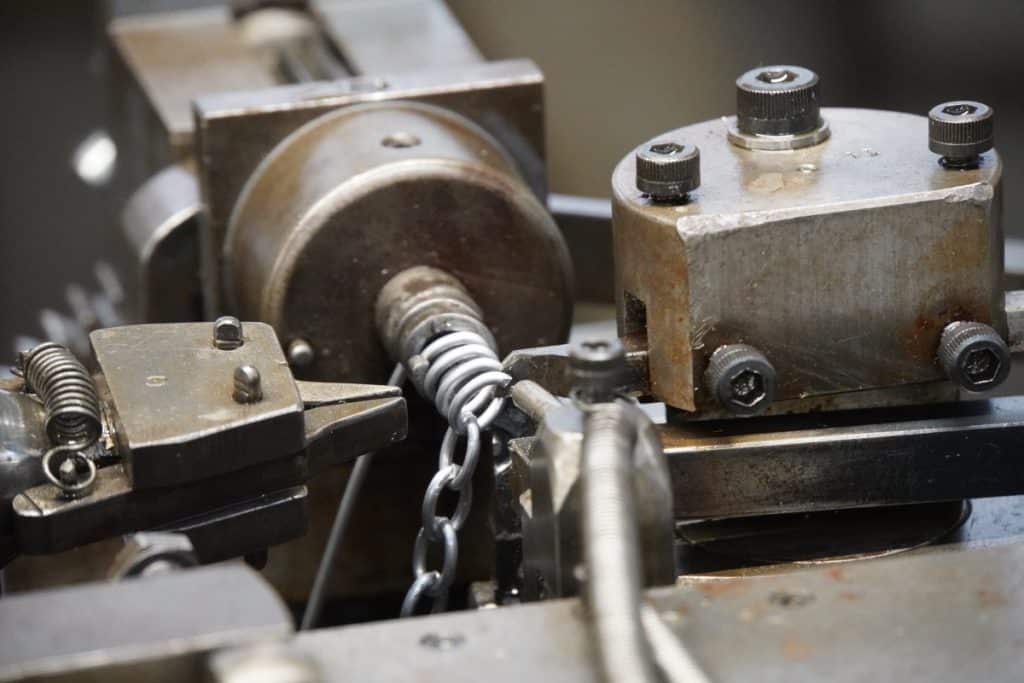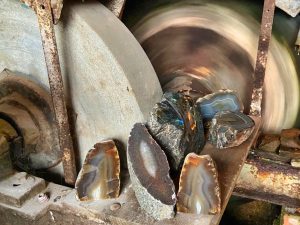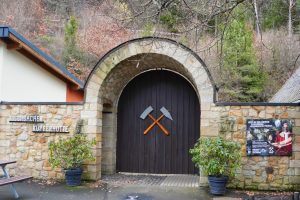Probably one of the best-known fashion jewelry factories in EdelSteinLand was the Jakob Bengel chain and fashion jewelry factory in the Oberstein district. Today, you can visit the Jakob Bengel industrial monument and take a look inside the former production facility on a guided tour.
In the middle of the 19th century, the towns of Idar and Oberstein developed into centers of jewelry manufacturing in Germany. In Oberstein, metalworking companies were founded at the end of the 19th century, specializing, among other things, in the production of watch chains. During the First World War, when the wristwatch slowly replaced the pocket watch, the companies in Oberstein sought other fields of work and shifted their production to the fashion jewelry sector. At the peak of production, about 5000 people earned their wages from jewelry production in the factories and home work.

In the 1970s, stricter environmental regulations and competition from low-wage countries changed the work in the companies so much that they were no longer competitive. Gradually, the factories closed and today there are only a few jewelry factories left in the area.
Beginnings of the company history of Jakob Bengel
The locksmith Jakob Bengel was one of the major producers of chain and fashion jewelry in Oberstein. Bengel had his factory building, with the apartment on the upper floor, built in 1873. Here he wanted to produce watch chains that everyone could afford. He developed the necessary machines to match his production. Business was good and it was important to Jakob Bengel that his workers also benefited. In 1890, a very modern building for the factory workers was built on the company premises. Their apartments all had electricity and running water.

In 1906, Bengel’s son-in-law took over the business. Bengel himself apparently did not want to lay his hands on the company. He continued to work in the company as an employee. In addition, he built two more residential houses for the company employees. The new company owner had a villa built right next to the company headquarters and moved in with his family.
The buildings are still standing in Idar-Oberstein today and in the old factory you can still see the machines of the company on a tour and get interesting insights into the work processes.

What happened to the Bengel company?
In 1914 the company expanded its production and manufactured fashion jewelry. In the 1920s and 1930s they became one of the leading manufacturers of jewelry in the style of Art Deco. Instead of gemstones, they used the plastic material galalith and made jewelry elements from it. Galalith is a material made from milk (also called milkstone). The material can be dyed, drilled, milled, ground and also polished and thus offered new design possibilities in jewelry production.
Around 1939, the government of the time banned the use of the plastic in jewelry production, it was needed for the armaments industry. In order not to have to work in the armaments industry, like so many other companies, the management decided to change production and now manufacture mothers’ merit crosses. In this way, the company could continue to employ the workers.

After the Second World War, the anodizing age (electrolytically oxidized aluminum) began in fashion jewelry processing. These are products made of aluminum, which are immersed in anodizing baths in the machining process and thus refined. The material can be produced in any desired color. Fashion jewelry production boomed in Oberstein and the Bengel company was one of the leading producers in the region.
The end of fashion jewelry production
In 1978 already the 4th generation managed the chain and metal goods factory Jakob Bengel. The production of fake fashion jewelry had been moved abroad. There the company could produce more economically. Fashion chains continued to be manufactured in Oberstein.

In 1993 the market collapsed. More and more companies closed down and the Bengel company hardly produced any more. When in 1995 the flood of the river Nahe inundated the production facilities, this was the end of production.
With the establishment of the Jakob Bengel Foundation, it was possible to preserve the building infrastructure, machines, tools, samples, as well as the historical equipment. Today it is possible to visit the factory building with a guided tour. The work on various machines is demonstrated and thus the production of chains and costume jewelry is explained.

Manufacture of chains
Our tour of the Jakob Bengel industrial monument begins in the chain machine hall, which since 1932 has increased the production area with an extension. Here are about 50 machines that were operated by only three workers during production. Jakob Bengel developed these machines in cooperation with a Berlin sewing machine manufacturer. Until that time, there was no machine on the market that could meet his needs and produce chains.

We took a closer look at one of the machines and were able to observe the process of chain production by machine. When the machine was running, my first thought was – what a racket that must have been when 50 machines were working at the same time. Even one machine is so loud that it is difficult to communicate.

Actually, a fairly simple process in which a spirally bent wire is cut off at the coil, then twisted a bit and hooked into a chain link. After the now new chain link is closed, the process starts all over again. I am immensely impressed by how this process has been implemented by machine, what an invention!
How the fashion jewelry was born
During our tour of the Jakob Bengel industrial monument, we also learn how fashion jewelry was made here.
First, the steel engraver made a pattern of the jewelry using a hammer and chisel. This was then processed into a negative impression (“die”). The factory still has countless of these negative impressions, which today offer an excellent insight into the patterns and designs of the time.

With the help of the die, the workers stamped the material in a huge machine with enormous weights. At another station, the fine work then took place until the piece of jewelry was finished.
We were able to follow the process very well on site during the minting of the “Bengel”, a commemorative coin that can be purchased in the museum store.

I also found the chasing machine very exciting. Chasing is a particular form of metalworking that creates lines and relief sculptural forms. With the help of the machine in the Jakob Bengel industrial monument and after another skillful bending of the wire, a beautiful bangle was created.

Museum store
After the impressive tour, the visitor can purchase pieces of jewelry in the original design of the Jakob Bengel company in the museum store. These are made according to patterns from the company’s pattern books and with the tools just visited. The jewelry is available for purchase in a limited edition with a certificate from the Jakob Bengel Foundation.
Address:
Wilhelmstraße 42a
55743 Idar-Oberstein
Opening hours:
March 15 – November 15
Tuesday – Sunday: 10 -17 h
November 16 – March 14
Special opening and guided tour are available upon request.
closed:
23 December – 02 January, Shrove Tuesday
Guided tours:
The visit to the historic factory is only possible within the framework of a guided tour of about one hour.
Entrance fees:
Adults: 9,-€
Discounts are offered.
The visit to the Jakob Bengel industrial monument took place as part of a press trip to EdelSteinLand.










Leave a Reply